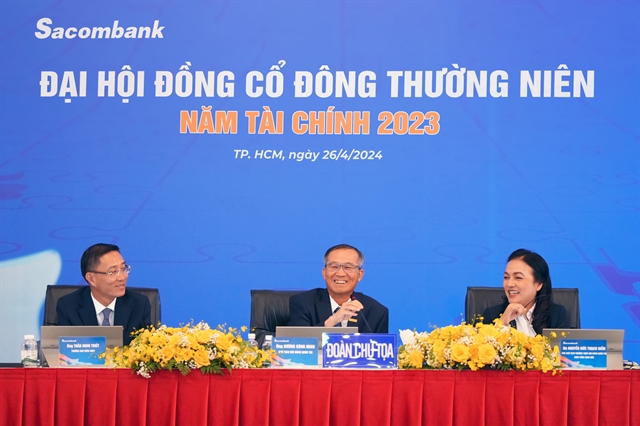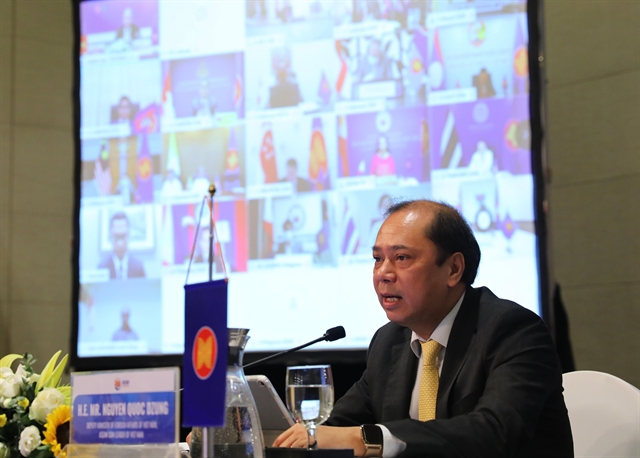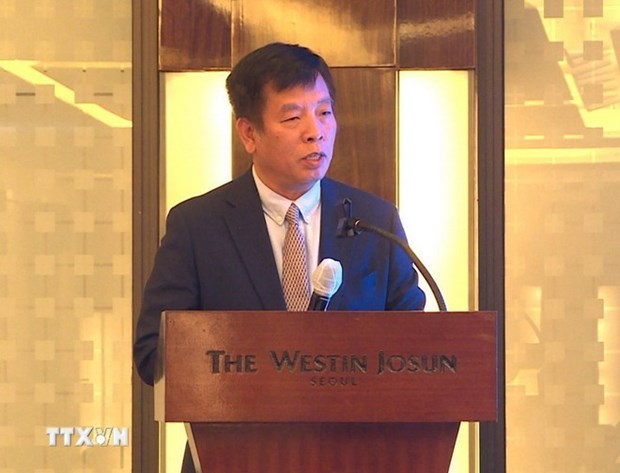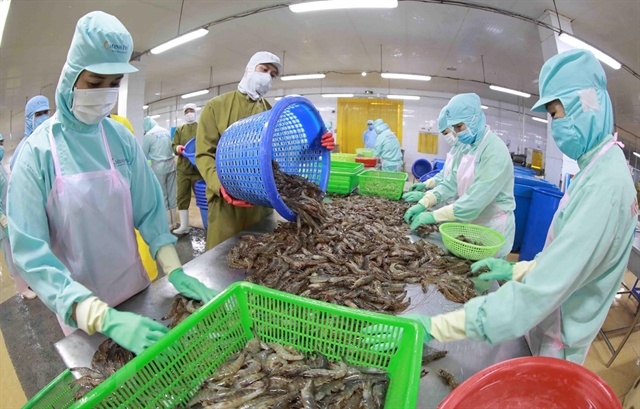 Politics & Laws
Politics & Laws


|
| Vietnamese Deputy Foreign Minister Nguyễn Quốc Dũng delivered the opening speech at the mulit-sectoral brainstorming discussion on the ASEAN Community Vision Post-2025. — VNA/VNS Photo Bùi Lâm Khánh |
HÀ NỘI — ASEAN needs to continue to demonstrate its central role and be the driving force of dialogues and confidence-building to ensure peace and security, against the backdrop of volatile regional and international concerns.
Vietnamese Deputy Foreign Minister Nguyễn Quốc Dũng made the statement at Monday’s inter-sectoral meeting between senior officials to brainstorm the ASEAN Community Vision Post-2025.
The Vietnamese diplomat, who chaired the discussion as Việt Nam this year holds the chairmanship of the Southeast Asian regional bloc, stressed that ASEAN need to “respond more effectively and proactively to the arising challenges”, as well as make more proactive contributions to efforts in maintaining peace and promoting prosperity in the international community.
The meeting was attended by senior officials from ASEAN member states on three community pillars: Political-Security Community, Economic Community, and Socio-Cultural Community, as well as ASEAN deputy secretaries-general.
In his opening speech, Dũng stressed that five years into the establishment of the ASEAN Community, the bloc is facing a number of challenges and opportunities in a fast changing and complex world.
“Throughout the past five decades, ASEAN has always proven its proactive, forward-thinking and visionary approach in finding development paths to adapt to changing circumstances and maintain its relevance,” Dũng said.
Building upon a comprehensive report on ASEAN Vision 2040, initiated by Thailand and formulated by ERIA (Economic Research Institute for ASEAN and East Asia) during the country’s chairmanship in 2019, Việt Nam wished to follow up to the idea in moving forward the development of the ASEAN Community Vision beyond 2025, he added.
Furthering the discussion held within the framework of ASEAN Senior Officials Meetings in Đà Nẵng, in March this year, the brainstorming session gathered input and contributions from the three ASEAN Community pillars to be submitted to the ASEAN Coordinating Council for their further guidance, the Vietnamese diplomat said.
During the meeting, ASEAN countries have expressed appreciation to Việt Nam’s timely push to shape the future of the bloc.
The member states agreed they would coordinate closely with Việt Nam in discussions for the ASEAN Community Vision Post-2025.
Digital transformation, promoting digital economy, inclusive growth, and stepping up information campaigns to bring the concept of ASEAN Community closer to the people, and enhancing the international standing of ASEAN, were issues highlighted by member states during the discussion.
ASEAN countries have also proposed focusing on measures to improve the efficiency of ASEAN's apparatus, inter-sectoral and inter-pillar cooperation, and increase the participation of all sectors in building the Community – including the parliament channel (AIPA – ASEAN Inter-Parliamentary Assembly), the academia and research channel, the business channel (ABAC – ASEAN Business Advisory Council), and social organisations.
Representatives of specialised cooperation agencies welcomed the inter-sectoral meeting initiative of Việt Nam and contributions of many important and diverse ideas.
Sharing Việt Nam’s perspective, Dũng stressed the ASEAN Community Vision should see enhancements of economic links as a foundation to form other connections in the ASEAN Community.
“ASEAN must uphold an inclusive approach, ensuring the sustainable and equitable development between regions of the country, between different parts of the society and between the countries, in order to leave no one behind,” Dũng noted.
The Deputy Minister suggested ASEAN should pay full attention to linking sub-regional development with the general development process of the ASEAN Community, building a community that places people at the centre of development.
“The process of discussing the ASEAN Community Vision after 2025 should be combined with the mid-term assessment of the ASEAN Community Vision 2025, which is also one of Việt Nam’s priorities as the Chair of ASEAN 2020."
The ASEAN Secretariat said that in hindsight, the development of ASEAN Community Vision 2025 should have been started earlier rather than its commencement in 2013 to allow for more preparations.
A visioning exercise for the ASEAN requires “leadership, political will and a high-level mechanism”, it said.
The Secretariat also pointed to the possibility that increasingly complex transnational challenges may force ASEAN to rethink delivery and effectiveness of a pillar-by-pillar or sector-by-sector approach.
Founded in 1967, the Southeast Asia regional bloc now comprises 10 member countries – Brunei, Cambodia, Indonesia, Laos, Malaysia, Myanmar, the Philippines, Singapore, Thailand, and Việt Nam.
Việt Nam plans to hold more consultations with different sectors and social organisations from ASEAN member states on the post 2025 vision, and put forward their proposals and suggestions to ASEAN leaders during the 37th ASEAN summit (scheduled for November this year). — VNS









